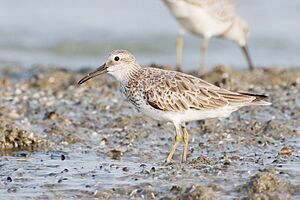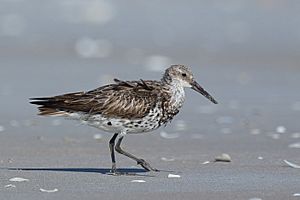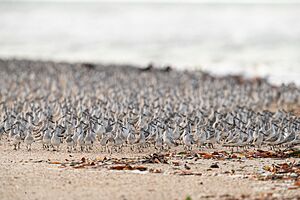Great knot facts for kids
Quick facts for kids Great knot |
|
|---|---|
 |
|
| Nonbreeding | |
 |
|
| Breeding | |
| Conservation status | |
| Scientific classification | |
| Genus: |
Calidris
|
| Species: |
tenuirostris
|
The great knot (Calidris tenuirostris) is a type of small wader bird. It's the biggest bird in its group, called Calidris. These birds are migratory, meaning they fly long distances. They spend their summers breeding in Siberia, Russia. When winter comes in the north, they fly south to places like southern Asia and Australia.
What's in a Name?
The name Calidris comes from an old Greek word, kalidris. This word was used by a famous thinker named Aristotle for grey birds that lived near water. The second part of its scientific name, tenuirostris, comes from Latin words. Tenuis means "slender" and rostrum means "bill". So, its name describes its thin beak!
Where Do Great Knots Live?
Great knots breed in the tundra areas of northeast Siberia, Russia. They make their nests on the ground, laying about four eggs in a small dip. These birds are very migratory. This means they travel far away for winter. They spend winter on coasts in southern Asia and all the way to Australia. In winter, they often gather in huge groups.
Sometimes, a few great knots are seen in western Alaska, United States. They have also been seen by chance in British Columbia, Canada, and in Oregon, West Virginia, and Maine in the U.S.
What Do Great Knots Look Like?

The great knot is the largest bird in the Calidris group, which includes many types of sandpipers. Its closest relative, the red knot, is the next largest.
Adult great knots are about 26 to 30 centimeters (10 to 12 inches) long. Their wings can spread out 56 to 66 centimeters (22 to 26 inches). They usually weigh between 115 and 261 grams (4 to 9 ounces).
These birds have short, dark legs and a medium-length, thin, dark beak. When they are breeding, their upper feathers are greyish with some reddish-brown spots. Their face, throat, and chest have many black spots. They also have some streaks on their lower belly. In winter, their feathers turn a plain pale grey.
You can tell a great knot from a red knot by its breeding feathers. The red knot has a bright red face, throat, and chest. In other seasons, the great knot is bigger, has a longer beak, a deeper chest, and more streaks on its upper body.
How Do Great Knots Behave?
Great knots look for food on mudflats and beaches. They use their beaks to probe in the mud or pick up food they see. They mostly eat molluscs (like snails or clams) and insects.
Protecting the Great Knot
The great knot is a bird that is part of an important agreement. This agreement, called the Agreement on the Conservation of African-Eurasian Migratory Waterbirds (AEWA), helps protect migratory waterbirds.
Great Knot in Australia
Since May 5, 2016, the great knot has been listed as critically endangered in Australia. This means it is at a very high risk of becoming extinct. This listing is under Australia's main environmental law, the Environment Protection and Biodiversity Conservation Act 1999 (EPBC Act).
A study in March 2023 suggested that the great knot's numbers might be more stable now. This means it might not be as threatened as once thought. However, it is still listed as critically endangered.
In different parts of Australia, the great knot has different protection levels:
- In New South Wales and the Northern Territory, it is listed as vulnerable.
- In South Australia, it is listed as endangered.
- In Queensland, Victoria, and Western Australia, it is listed as critically endangered.



